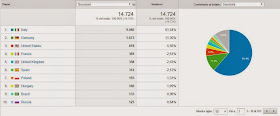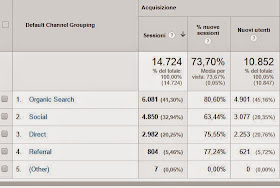Translation by Francesco Mazzaferro
A few numbers on Letteratura artistica (Art Literature)
 |
| Fig. 1) |
Today we would like to provide some data on Letteratura artistica. The analysis of
available statistics can give some useful information on dissemination and modalities
of its use.
What statistics to
use?
It is the first problem. Although it may seem
strange to newcomers, the reporting systems vary greatly from each another and
produce results that can differ. For example, the reporting of Blogger – i.e. the Google platform on
which Letteratura artistica has been created
and runs - displays states more than
116,000 page visualisations from its inception (November 15, 2013) to date (previously
excluding consultations by those who create the pages).
This figure is overestimated, since it
includes, for example, also all situations in which robots of search engines
explore the individual posts, to analyse and classify them in their charts.
Traditionally, it is considered that the most
accurate statistics, and those best expressing the real use of a network tool,
are from Google Analytics. In Analytics, for example, the explorations
of the robots of search engines are not included; thus, numbers are lower, but
truthful. We too will use this tool with respect to the period August 22, 2014
- February 22, 2015 (i.e. during the last six months).
How many sessions? How many viewed pages? How many unique users?
In the past six months, the consultation
sessions of Letteratura Artistica
(i.e. the number of times
someone has consulted the blog) have been 14,724 (figs. 1 and 2). On the whole, the viewed
pages have been 28,368. On average, each user has therefore consulted 1.93
pages for consultations. The number of unique users (i.e. diverse people) who consulted
the blog is 10,996. 26.3% of users visited again the website. 73.7% saw it once
only. The average time of consultation of each session (i.e. the average among those
who were there, for instance, only one second on the page and those who stayed,
for example, a full half-hour) is 1.39 minutes.
 |
| Fig. 2) |
From which countries?
61% of visits come from Italy (fig. 3). The remaining is
from the rest of the world (please remember that all pieces published on the
blog are both in Italian and in English). Altogether, there have been
consultations from 101 nations worldwide.
 |
| Fig. 3) |
After Italy, the second place in the ranking by
nation is clearly for Germany. Then come the United States, France, England,
Spain, Poland, Hungary, Brazil and Russia. The remaining 10.5% of the sessions
is divided among ca. other ninety states.
From which cities?
Analytics provides a list of 1,674 locations
around the world for the connections to Letteratura artistica. We are sparing you the full list.
The first ten locations (fig. 4) are Rome (1,604 sessions),
Milan (1,482), Frankfurt (1,212), Bologna (747), Florence (408), Naples (302),
Turin (259), London (186), Catania (178) and Palermo (171).
 |
| Fig. 4) |
Among the top 50 locations also appear Paris
(11th), Madrid (13th), Warsaw (22nd), New York (25th), Budapest (26th), Berlin
(30th), Bochum (31st), Moscow (34th), San Francisco (38th), San Paulo (39th),
Athens (44th), Buenos Aires (45th), Vienna (47th) and Lugano (50th).
Out of curiosity, the first Italian town not
being a provincial capital is Fano (in 67th place with 29 sessions).
How do users get to the
blog?
A perfectly legitimate question: how do users get
to know of the existence of Letteratura artistica and to consult it? Technically, this equals
identifying the channels for the acquisition of the public. Normally, in a
commercial site (with any brand that is not extremely famous) the acquisition
mode is advertising. Here (except what we are going to say below for Facebook) no
advertising investment has been made.
41% of visits come from search engine results.
A user makes, for example, a search on Google
and finds the link to the relevant page of Letteratura artistica. Of course, in order to be found one must know how to be found. If you review a book
about The Book Art of Cennino Cennini,
for instance, you must assume that someone else (from a few thousand up to a
few million individuals) has posted something else on the subject. Knowing how
to be well indexed is therefore essential (but we would not dwell further on it,
as it might become a bit boring).
33% of the sessions come from social networks.
Almost all of them from Facebook. On Facebook, there is a dedicated page (not
surprisingly also called Letteratura
artistica), where posts
are published announcing the release of a new article in the blog. The posts
are always in Italian and English, and each time they are advertised (in the
sense that you set a specific advertising campaign on the social network) with
a total expenditure of € 3 for each post. The users to whom the advertising is
addressed are selected from among those who (in the archives of Facebook) are categorised as having an interest
in art.
 |
| Fig. 5) |
20% of readers enter the blog by typing the
address directly. Approximately 5% comes to us through other sites that
indicate the link (in practice, they are spontaneously testimonial).
The average reader
Analytics also allows the collection of more
'sensitive' information on readers: from demographics to personal interests and
so on. Given that Letteratura artistica is not a commercial site and is not concerned then to collect, store and resell
data for marketing, these functions have not
been activated. However, aggregate information on individuals can be collected
from Facebook.
The audience from Facebook is only part of what visits the website (as mentioned
above, it is 33% of the total). The Facebook
page Letteratura artistica has about 6,000 fans. If it is not
absolutely certain that all 6000 have visited the site, it is nevertheless reasonable
to think that most of them did it.
According to the statistics provided by Facebook we know that:
68% of fans are females, 32% are men (the
overall average of Facebook in the
world is 46% women and 54% men). The age distribution is very different from
that of the total members to the channel. It is well below average (it does not
get 1%) with regard to minors (which are 14% of the members of Facebook), but it is higher in all
following age groups (slightly higher first and then sharply higher for older
age buckets). 22% of the fans have between 18 and 24 years, 26% between 25 and
34, 18% between 35 and 44 years; 17% between 45 and 54, 10% between 55 and 64
years, and finally 5% over 65 years.
From these data, it is reasonable to assume
that the average reader of the blog is actually a female reader, and she is a
little over 35 years.
In summary
A short summary: first of all, we would have not
expected these figures. To be clear, they are still pretty small numbers, if
you think in terms of commercial blogs, but are absolutely flattering for a private
niche initiative like ours.
It seems trivial, but it is actually the most
important thing: the success of Letteratura
artistica is the result of the quality of the content which is offered. The
percentage of returns (over 26%) is indeed very high, for a site that has
started from scratch and did not profit from any brand at its start. Evidently,
our readers find here those subjects, which are difficult to find elsewhere. Letteratura artistica has therefore become
a sort of small Wikipedia, for history of art sources.
Nessun commento:
Posta un commento